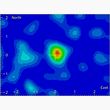Muons are like the big brother of electrons but they are heavier and much more penetrating. About 1000 pass through the room every second. They are generated when cosmic rays interact with atoms in the upper atmosphere to form secondary rays called muons.
We all know that X-rays are used to look at body parts that are hidden in soft tissue.
- A beam of X-rays is focused on an object
- A detector (X-ray film) is placed on the other side of the object
- Density differences between soft tissues and bones etc. enable the interior to be seen
Muon tomography (imaging with muons) uses an identical method (but muons are free and do not need expensive equipment to generate them!)
Lee did not give details of the muon detector but said that muons come from above and also some came from the sides. They are eventually all absorbed by the soil and rocks until several hundred metres below the surface.
Tomography has been used to find hidden chambers in the Great Pyramid.
Muons coming from the side have been used to image magma chambers in volcanoes. In this case images of the top of the magma column before and after an eruption were used to predict further eruptions.
On the railways in the U.K. there are many tunnels dating back to the Victorians. Often tunnels were made by sinking shafts to the depth of where the tunnel was to be made. Then crews dug horizontally in both directions until they met up with other similar parts of the tunnel. In many cases these shafts were filled in (with rubble) or some were left open as air shafts. Some of the shafts are not stable now and some tunnel roofs are in danger of collapse. However, very few records of where these shafts were dug are available.
The rail companies have a programme to avoid more collapses but they cannot close tunnels that are in use. They send in teams of drillers on scaffolding to drill into the roofs of tunnels. This is a problem because it takes lots of men, lots of time, only a few areas can be examined and the drilling may weaken the roofs.
Lee’s work is aimed at finding hidden shafts using muon tomography. British Rail is allowing his team to use muon tomography in Alfreton Old Tunnel, which is 760 metres long and disused.
The team have built a muon detector small enough to fit into a Transit van. They moved the van into the tunnel and took readings for 30 minutes then moved on 5 metres and took more readings for 30 minutes and so on.
The graph of the readings showed high readings before they entered the tunnel then fell off at the tunnel entrance as the overburden above the tunnel absorbed the muons.
The graph showed steady low readings for a length of tunnel then the readings rose slightly at one spot then dropped back for a length and then rose again and so on.
The rail company had told Lee’s team where two shafts were but they found three areas where the reading rose. Two were at the areas they expected, but they found three possible shafts. The company then admitted that they knew of the third shaft 80 metres into the tunnel, but they were testing the team to be sure their results were genuine.
Lee’s team went back and did another more detailed survey of this tunnel and found that other “hot spots” gave information about shafts with only 5 metres of overburden suggesting more part-filled, unknown shafts.
This method needs cooperation from a geological survey team. It is obvious that, if the surface of the overburden land is not flat, then the overburden will be thicker in some parts than others and will absorb more muons. This has to be allowed for when interpreting the tomography results.
Muon tomography can be used to detect smuggled nuclear material. If a detector is placed under and around the sides of suspected vehicles then uranium and plutonium will deflect muons but light materials will not and this will show up on the results.
Nuclear waste from 1950 -60 is poorly documented. Canisters can be checked by muon tomography to find if they are full or if they have leaked.
There may be many other uses for muon tomography that will be developed in the future.
Lee’s team are still working on it!
This was an extremely interesting talk for all, but especially for this ex-Chemistry teacher.

